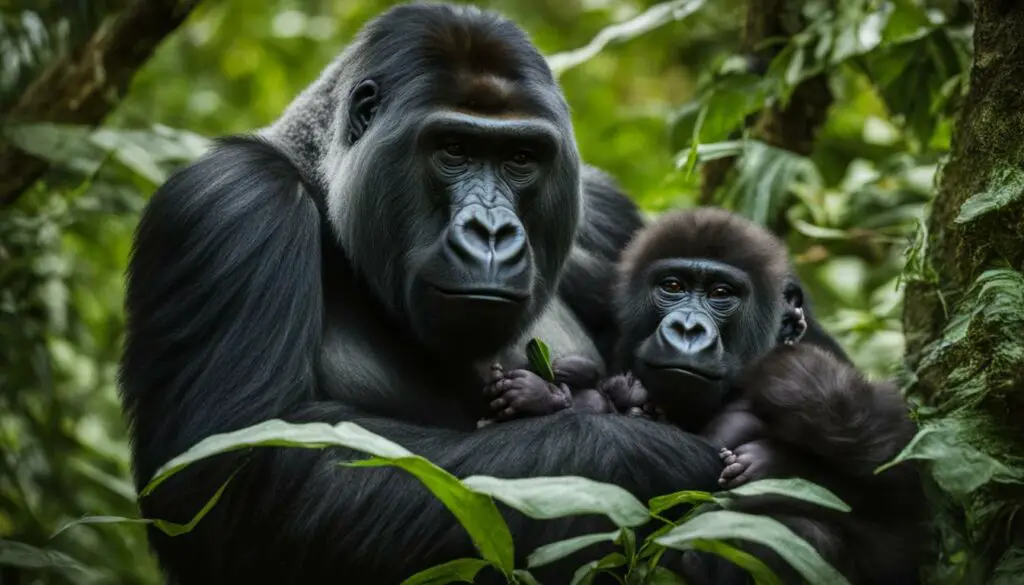Gorilla reproduction is a fascinating topic that offers insights into their mating behaviors and reproductive cycle. Understanding how gorillas reproduce is essential for comprehending their population dynamics and social dynamics within groups. In this article, we will explore the different aspects of gorilla reproduction, including their mating behaviors, sexual maturity, reproductive cycle, infant care, and mating habits. So let’s dive into the world of gorilla reproduction and learn more about these incredible creatures.
In the first section, we will delve into the mating behaviors of gorillas and explore how they engage in courtship rituals and mate year-round. It’s fascinating to discover how only the dominant silverback has breeding rights and mates with several females in the troop.
Sexual Maturity in Gorillas
Female gorillas reach sexual maturity around 7 to 8 years of age, although they typically do not reproduce until they are 10 years old. On the other hand, male gorillas reach sexual maturity later, between 15 to 20 years of age. This difference in maturity age allows for the development of social dynamics within gorilla troops, where the dominant silverback has exclusive breeding rights.
At around 10 years old, female gorillas are capable of reproducing. They may breed year-round, but females are in estrus, or in heat, for only 1 to 2 days per month. During this fertile period, the dominant silverback mates with multiple females in the troop. This polygamous behavior is characteristic of gorillas and ensures the continuity of their species.
In summary, gorillas have a distinctive reproductive cycle with sexual maturity occurring at different ages for males and females. Female gorillas reach sexual maturity earlier, around 7 to 8 years old, while male gorillas mature later, typically between 15 to 20 years old. This difference in maturity allows for the establishment of a dominant silverback within a troop who has exclusive breeding rights.
Mating Behavior of Gorillas
Gorillas, being social animals, exhibit fascinating mating behavior and courtship rituals. These behaviors play a crucial role in their reproduction cycle and the dynamics within their troops. Mating among gorillas can occur throughout the year, and females experience monthly estrus cycles lasting 1 to 2 days. During this time, the dominant silverback, who has exclusive breeding rights, mates with multiple females in the troop.
One notable courtship ritual observed in gorillas is the approach of females towards the dominant male. In this display, females make sustained eye contact with the silverback, emphasizing their interest in mating. This behavior signals their receptivity and readiness to engage in the mating process. Interestingly, both the female and the silverback can initiate mating, further underscoring the complexity of gorilla mating behavior.
“Gorillas engage in courtship rituals, with females approaching the dominant male and making sustained eye contact.”
Actual copulation in gorillas occurs on the ground, and it can be incited by various behaviors or displays. In some cases, males may initiate mating by performing displays or touching the female. On the other hand, females may try to attract the male’s attention by reaching towards him or even slapping the ground. These diverse courtship behaviors add depth to the understanding of gorilla mating habits and highlight the intricate dynamics of their reproductive cycle.
Table: Gorilla Mating Behavior
| Behavior | Description |
|---|---|
| Monthly Estrus Cycle | Females experience estrus for 1 to 2 days per month, indicating their fertility. |
| Dominant Silverback Breeding | Only the dominant silverback has breeding rights and mates with multiple females in the troop. |
| Courtship Rituals | Females approach the dominant male, making sustained eye contact to express their receptiveness. |
| Mutual Initiation of Mating | Both the female and the silverback can initiate mating through various behaviors or displays. |
Gorilla mating behavior showcases the sophisticated social dynamics within their troops. By understanding these behaviors, researchers gain insights into the complex reproductive cycle of gorillas and can contribute to their conservation and welfare.
Gorilla Reproductive Cycle
The reproductive cycle of gorillas involves various stages and processes that contribute to the population dynamics of these magnificent primates. Female gorillas typically have a gestation period of about 8.5 months, which is similar to the gestation period of humans. This means that gorilla mothers carry their young for a relatively long period of time before giving birth. The gorilla gestation period is an essential part of their reproductive cycle, ensuring the proper development of the offspring.
After the gestation period, female gorillas give birth to a single infant, weighing around 2 kg. This newborn gorilla is entirely dependent on its mother for care and protection. The mother carries the infant on her back for the first three months of its life, ensuring its safety and nourishment. This close bond between the mother and the infant is crucial for the survival and well-being of the young gorilla.
Female gorillas typically give birth about once every four years, although this can vary among individuals. Unlike some other species, gorillas do not have a fixed breeding season. Instead, they mate year-round, ensuring the continuation of their population. The reproductive cycle of gorillas is fascinating, with females reaching reproductive maturity around 10 years of age.
| Key Points | Details |
|---|---|
| Gestation Period | About 8.5 months |
| Birth Interval | About once every four years |
| Number of Offspring | Usually one at a time |
| Reproductive Maturity | Around 10 years of age |
The reproductive cycle of gorillas is an intricate and vital process for the survival of their species. Understanding the specifics of their reproductive cycle helps researchers and conservationists develop effective strategies to protect and conserve these incredible creatures.
Gorilla Infant Care and the Mother-Infant Bond

Gorilla infants are highly dependent on their mothers for survival, and the mother-infant bond plays a vital role in their care. Female gorillas are the primary caregivers and provide nurturing and protection to their young. Male gorillas, including the dominant silverback, are not actively involved in infant care.
During the first four months of their lives, gorilla infants nurse from their mothers, receiving essential nutrients and antibodies that help strengthen their immune systems. This nursing period is crucial for the growth and development of the infants. After the nursing phase, the infants begin riding on their mothers’ backs, holding on tightly to their fur. This mode of transportation allows the mothers to carry their young while foraging and moving through their habitat.
The mother-infant bond in gorillas is vital for the survival and well-being of the infants. The silverback, as the leader of the group, also plays a protective role in ensuring the safety of the infants. They provide a shield against potential threats and aggression from other group members, safeguarding the vulnerable infants.
The Role of Female Gorillas in Infant Care
Female gorillas demonstrate exceptional maternal instincts. They are attentive to the needs of their infants, providing them with warmth, grooming, and social interaction. Mothers engage in play with their young, helping them develop essential motor skills. They also teach them important social behaviors and how to navigate their complex social structure.
The mother-infant bond remains strong throughout the infancy stage and continues to play a crucial role even as the infants grow older. As the infants mature, they gradually gain more independence but still rely on their mothers for support and guidance until they reach adulthood.
The Importance of the Silverback’s Protection
While female gorillas are primarily responsible for infant care, the silverback plays a critical role in protecting the infants from potential dangers. They act as the alpha male and maintain order within the group, ensuring the safety and well-being of all members, including the infants. Their presence alone serves as a deterrent to potential aggression from other group members and outsiders.
The silverback’s protective nature extends to defending the group against perceived threats from rival males or other potential dangers in their environment. Their strength and size serve as a deterrent to potential predators, playing a vital role in keeping the group safe and secure.
| Infant Care in Gorillas | Mother-Infant Bond | Silverback’s Protection |
|---|---|---|
| Females are the primary caregivers | Mother-infant bond is crucial for survival | Silverback provides protection for the infants |
| Infants nurse from their mothers | Mother-infant bond helps with growth and development | Silverback acts as the alpha male and safeguards the group |
| Infants ride on their mothers’ backs | Female gorillas demonstrate exceptional maternal instincts | Silverback defends against potential threats and aggression |
| Mother-infant bond remains strong throughout infancy | Mother provides warmth, grooming, and social interaction | Silverback’s presence serves as a deterrent to aggression |
Gorilla Mating Habits
Gorillas engage in fascinating mating habits that play a crucial role in their reproductive cycle and social dynamics. The dominant silverback, the alpha male of the group, has exclusive breeding rights and mates with all the females in the troop. Mating occurs year-round, but females are only in estrus for 1 to 2 days per month, making these brief periods crucial for successful reproduction.
Female gorillas may initiate mating by approaching the silverback and making sustained eye contact. If the male does not respond, the female may try to attract his attention by reaching towards him or slapping the ground. Males can also incite copulation by displaying or touching the female. These behaviors are part of the complex courtship rituals observed in gorillas.
To better understand gorilla mating habits, it is important to recognize the hierarchy within gorilla groups. The dominant silverback not only has breeding rights but also protects the females and their offspring from aggression within the group. This ensures the survival and reproductive success of the dominant male’s genes, contributing to the overall population dynamics of gorillas.
Understanding Gorilla Breeding Behavior
Gorilla breeding behavior involves a combination of social interactions, displays of dominance, and courtship rituals. The mating habits observed in gorillas highlight their complex social structure and the importance of the dominant silverback in the reproductive process. By studying and understanding these behaviors, we gain valuable insights into the remarkable world of gorilla reproduction.
Gorilla Reproduction and Social Dynamics
Gorilla reproduction is closely intertwined with their social dynamics, which are characterized by a dominant silverback and a troop of females. The dominant silverback is the only male with access to mating rights and typically mates with several females within the troop. This social structure ensures that only the strongest and most genetically fit males reproduce, contributing to the overall health and fitness of the gorilla population.
However, gorilla social dynamics can also involve aggression and competition. Young males, once they reach sexual maturity, often leave their birth group in search of females to form their own family group. In some cases, this can lead to conflicts and even violence, as young males may attempt to “kidnap” females from other groups. Sadly, these interactions can result in the death of infants, as rival males seek to establish dominance and secure their mating rights.
As female gorillas reach reproductive maturity, they may also transfer to another group or even join a lone silverback. This movement between groups allows for the exchange of genetic material and helps to maintain genetic diversity within the gorilla population. It also provides females with the opportunity to form new social bonds and establish themselves within a new social group.
Gorilla Reproductive System
The gorilla reproductive system is highly adapted for successful reproduction. Female gorillas have a typical gestation period of approximately 8.5 months, similar to that of humans. They give birth to a single offspring, usually once every four years. This slow reproductive rate is thought to be influenced by a combination of factors, including the extended period of maternal care required for gorilla infants.
The mother-infant bond is crucial for the survival of gorilla infants. Female gorillas play a primary role in caring for their young, providing them with nourishment through breastfeeding and carrying them on their backs once they are strong enough to hold on. The silverback also plays a protective role within the group, ensuring the safety of the infants and maintaining the social order.
Overall, the reproductive system and social dynamics of gorillas are fascinating and complex. Understanding these processes is vital for conservation efforts and ensuring the long-term survival of this incredible species.
Conclusion
Gorilla breeding and the reproduction cycle play a significant role in their population dynamics. The reproductive process in gorillas is a slow one, with females giving birth approximately once every four years. The gestation period lasts about 8.5 months, and births are typically single.
Female gorillas, as caregivers, play a crucial role in raising their infants, while the dominant silverback provides protection within the group. Gorilla mating habits vary, with the dominant male having exclusive breeding rights and engaging in mating year-round.
The social dynamics of gorillas involve the dominant silverback being the only male with access to females for mating. Other males often leave their birth group in an attempt to form their own family group by gathering females. However, this process can lead to aggression, as young males may try to “kidnap” females, sometimes resulting in the death of infants.
The fascinating reproductive cycle of gorillas, including the mating behaviors and care provided by females, contributes to the survival and growth of gorilla populations. Understanding these aspects is essential for ensuring the conservation and well-being of these incredible animals.
What is the mating and gestation period for gorillas and how do they care for their young?
Gorillas have a mating and gestation period of about eight and a half months. They give birth to one offspring at a time and care for them for several years. The raising gorilla offspring process involves the mother providing most of the care, while the father plays a protective role within the troop.
FAQ
How do gorillas reproduce, and what is their reproduction cycle?
Gorillas reproduce through sexual reproduction. The reproduction cycle in gorillas involves female gorillas reaching sexual maturity around 7 to 8 years of age, but they usually do not reproduce until they are 10 years old. Male gorillas mature later, between 15 to 20 years of age. Gorillas mate year-round, with females being in estrus for 1 to 2 days per month. Only the dominant silverback has breeding rights and mates with several females in the troop. Female gorillas have a gestation period of about 8.5 months and give birth about once every four years.
When do female gorillas reach sexual maturity?
Female gorillas become sexually mature at around 7 to 8 years of age, but they usually do not reproduce until they are 10 years old.
What is the mating behavior of gorillas?
Gorillas are polygamous, and only the dominant silverback has breeding rights within the troop. Gorillas may breed year-round, and females are in estrus for 1 to 2 days per month. Gorillas engage in courtship rituals, with females approaching the dominant male and making sustained eye contact. Mating can be initiated by either the female or the silverback, and actual copulation occurs on the ground.
What is the reproductive cycle of gorillas?
Gorillas have a reproductive cycle that involves year-round mating and a gestation period of about 8.5 months. Female gorillas give birth about once every four years, with no fixed breeding season. Most females reach reproductive maturity around 10 years of age.
How do gorillas care for their infants?
Gorilla infants are vulnerable and dependent on their mothers for survival. Mothers play a crucial role in caring for their young, while male gorillas are not actively involved in childcare. Infants nurse from their mothers for the first four months and then ride on their mothers’ backs. The mother-infant bond is essential, and the silverback protects the infants from aggression within the group.
What are the mating habits of gorillas?
Gorillas engage in mating and breeding year-round. The dominant silverback mates with all the females in the group when they are in estrus. Female gorillas may initiate mating by approaching the male and making eye contact. If the male does not respond, the female may try to attract his attention by reaching towards him or slapping the ground. Males can incite copulation by displaying or touching the female.
How does gorilla reproduction affect their social dynamics?
Gorilla reproduction plays a significant role in their social dynamics. The dominant silverback is the only male with access to females for mating. Most males leave their birth group and attempt to form their own family group by gathering females. Gorilla social dynamics can involve aggression, as young males may try to “kidnap” females, sometimes resulting in the death of infants. Females may transfer to another group or to a lone silverback after reaching reproductive maturity.
What is the conclusion about gorilla reproduction?
Gorilla reproduction is a slow process, with females giving birth about once every four years. The gestation period lasts about 8.5 months, and births are usually single. Female gorillas are important caregivers for their infants, while the silverback provides protection within the group. Gorilla mating habits vary, with the dominant silverback having breeding rights and engaging in mating year-round. The reproductive cycle of gorillas is fascinating and plays a vital role in their population dynamics.











